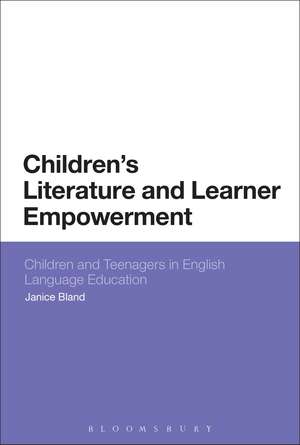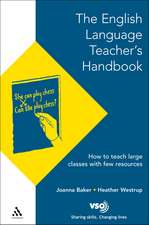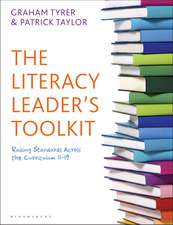Children's Literature and Learner Empowerment: Children and Teenagers in English Language Education
Autor Dr Janice Blanden Limba Engleză Paperback – 28 ian 2015
| Toate formatele și edițiile | Preț | Express |
|---|---|---|
| Paperback (1) | 259.90 lei 6-8 săpt. | |
| Bloomsbury Publishing – 28 ian 2015 | 259.90 lei 6-8 săpt. | |
| Hardback (1) | 893.15 lei 6-8 săpt. | |
| Bloomsbury Publishing – 3 iul 2013 | 893.15 lei 6-8 săpt. |
Preț: 259.90 lei
Preț vechi: 332.42 lei
-22% Nou
Puncte Express: 390
Preț estimativ în valută:
49.73€ • 51.92$ • 41.16£
49.73€ • 51.92$ • 41.16£
Carte tipărită la comandă
Livrare economică 04-18 aprilie
Preluare comenzi: 021 569.72.76
Specificații
ISBN-13: 9781474218351
ISBN-10: 1474218350
Pagini: 344
Ilustrații: 45 illus
Dimensiuni: 156 x 234 x 18 mm
Greutate: 0.48 kg
Editura: Bloomsbury Publishing
Colecția Bloomsbury Academic
Locul publicării:London, United Kingdom
ISBN-10: 1474218350
Pagini: 344
Ilustrații: 45 illus
Dimensiuni: 156 x 234 x 18 mm
Greutate: 0.48 kg
Editura: Bloomsbury Publishing
Colecția Bloomsbury Academic
Locul publicării:London, United Kingdom
Caracteristici
Examines potential for children's literature as both second language acquisition support and content support
Notă biografică
Janice Bland is Professor of English Education at Nord University, Norway. She is co-editor of the peer-reviewed, open-access journal, Children's Literature in English Language Education.
Cuprins
Acknowledgements 1. Introduction: The EFL Literature Classroom Part I: Visual Literacy in the EFL Literature Classroom2. Developing the Mind's Eye with Picturebooks 3. Bridging a Curricular Gap with Graphic Novels Part II : Literary Literacy in the EFL-Literature Classroom4. Postmodern Fairy Tales: Co-constructing Meaning 5. The Poetry of Children's Literature and Creative Writing 6. Children's Plays: Beyond the Oracy/Literacy DichotomyPart III: Critical Cultural Literacy in the EFL Literature Classroom7. Radical Children's Literature and Engaged Reading 8. Harry Potter and Critical Cultural Literacy Conclusion Bibliography ReferencesIndex
Recenzii
This is an important publication for all working in English language education, not only for those working and researching young learner and teenage learning, but for those involved in reading and in the reading of literature ... Bland writes clearly and intelligently and has productively absorbed and applied a wealth of relevant and recent research ... I am convinced [this book] will become widely cited and known as more relevant readers find it, read it and see the need to recommend the author and the title ... and I would be pleased if this review can contribute to a speedier uptake of the ideas found therein
Relevant and accessible ... For me undoubtedly [this book's] strongest point is that every approach advocated is exemplified with engaging texts and tasks. The book is very persuasive in that all its major points are supported by relevant references to credible research ... [A] very impressive and valuable book which I really enjoyed reading.
This is a comprehensive, innovative and thematically coherent book which provides powerful arguments for engaging with a wide variety of genres within children's and young adult literature ... A worthwhile contribution to modern EFL teaching methodology
With confident writing on children's literature as a 'highly expressive carrier of cultural meaning', the book contains excellent close readings of many picturebooks and graphic novels ... Packed with good ideas for using selected books as positive resources for literary language learning
Bland's volume does indeed fulfil her aim of generating a rationale for selecting works of children's literature for use in EFL classrooms and identifying how certain kinds of literature might empower learners ... I have already added it to my own student teachers' reading lists.
[An] impressive feature of the book is the close segmental reading of diverse examples of children's literature and graphic novels ... Children's Literature and Learner Empowerment provides a theoretical and practical approach to providing ELL primary and secondary school learners with the use of authentic and engaging materials.
It is quite natural to expect a book like this from Janice Bland ... Bland communicates her ideas fluently ... and she offers abundant references that are often interwoven with her own thoughts. She manages to construct a clear message that certainly finds its way to the reader ... In this way, student teachers are led in a valuable direction
Put tersely, Bland's Children's Literature and Learner Empowerment is a spirited argument for using original, unabridged children's and YA literature in the EFL classroom in place of truncated, artificial texts ... [Bland's book] offer[s] insights and arguments that will be valid long after academic capitalism has passed from the scene. No matter where your specific interest in children's literature lies, these are important books to read.
This is a comprehensive, innovative, thought-provoking and topical book on children's literature which is equally relevant to scholars working in the field plus to teachers and students of languages and literature.
At a time when there is an increasing demand for the effective teaching of EFL and ESL/EAL, this book provides powerful arguments for engaging with a wide variety of genres within children's and young adult literature and shows how constructing meaning from 'well-crafted' texts - including visual and radical texts - can help develop 'literary literacy' for children of all ages. Teacher educators will benefit most from the interdisciplinary nature of the book as the author shows how children's literature scholarship is linked to TEFL theory and practice. However, the result of bringing these two fields together provides exciting new perspectives for all those interested in critical reading and creative writing with children and teenagers.
Janice Bland's new book is careful, precise and very fully referenced. She makes a compelling case for the need for teachers and other educators to pay more serious attention to the potential offered by children's picturebooks. Literary and visual experience is shown to lead to engagement and creative thinking in the classroom which graded readers, extracts or non-fictional materials are unlikely to stimulate. Teachers of the ever-growing numbers of young learners of English in particular should pay close attention to this book. It should be on teacher training booklists and on the shelves of all good Education libraries.
Relevant and accessible ... For me undoubtedly [this book's] strongest point is that every approach advocated is exemplified with engaging texts and tasks. The book is very persuasive in that all its major points are supported by relevant references to credible research ... [A] very impressive and valuable book which I really enjoyed reading.
This is a comprehensive, innovative and thematically coherent book which provides powerful arguments for engaging with a wide variety of genres within children's and young adult literature ... A worthwhile contribution to modern EFL teaching methodology
With confident writing on children's literature as a 'highly expressive carrier of cultural meaning', the book contains excellent close readings of many picturebooks and graphic novels ... Packed with good ideas for using selected books as positive resources for literary language learning
Bland's volume does indeed fulfil her aim of generating a rationale for selecting works of children's literature for use in EFL classrooms and identifying how certain kinds of literature might empower learners ... I have already added it to my own student teachers' reading lists.
[An] impressive feature of the book is the close segmental reading of diverse examples of children's literature and graphic novels ... Children's Literature and Learner Empowerment provides a theoretical and practical approach to providing ELL primary and secondary school learners with the use of authentic and engaging materials.
It is quite natural to expect a book like this from Janice Bland ... Bland communicates her ideas fluently ... and she offers abundant references that are often interwoven with her own thoughts. She manages to construct a clear message that certainly finds its way to the reader ... In this way, student teachers are led in a valuable direction
Put tersely, Bland's Children's Literature and Learner Empowerment is a spirited argument for using original, unabridged children's and YA literature in the EFL classroom in place of truncated, artificial texts ... [Bland's book] offer[s] insights and arguments that will be valid long after academic capitalism has passed from the scene. No matter where your specific interest in children's literature lies, these are important books to read.
This is a comprehensive, innovative, thought-provoking and topical book on children's literature which is equally relevant to scholars working in the field plus to teachers and students of languages and literature.
At a time when there is an increasing demand for the effective teaching of EFL and ESL/EAL, this book provides powerful arguments for engaging with a wide variety of genres within children's and young adult literature and shows how constructing meaning from 'well-crafted' texts - including visual and radical texts - can help develop 'literary literacy' for children of all ages. Teacher educators will benefit most from the interdisciplinary nature of the book as the author shows how children's literature scholarship is linked to TEFL theory and practice. However, the result of bringing these two fields together provides exciting new perspectives for all those interested in critical reading and creative writing with children and teenagers.
Janice Bland's new book is careful, precise and very fully referenced. She makes a compelling case for the need for teachers and other educators to pay more serious attention to the potential offered by children's picturebooks. Literary and visual experience is shown to lead to engagement and creative thinking in the classroom which graded readers, extracts or non-fictional materials are unlikely to stimulate. Teachers of the ever-growing numbers of young learners of English in particular should pay close attention to this book. It should be on teacher training booklists and on the shelves of all good Education libraries.








